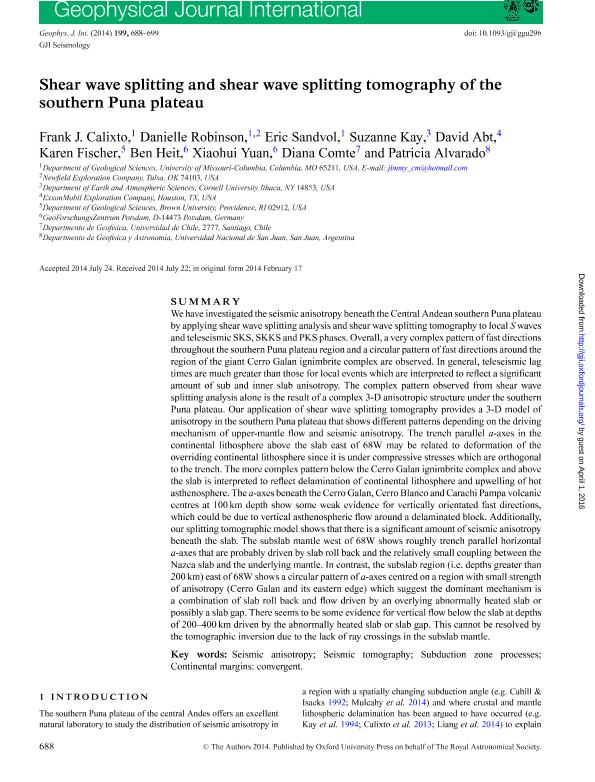Mostrar el registro sencillo del ítem
dc.contributor.author
Calixto, Frank J.
dc.contributor.author
Robinson, Danielle
dc.contributor.author
Sandvol, Eric
dc.contributor.author
Kay, Suzanne
dc.contributor.author
Abt, David
dc.contributor.author
Fischer, Karen
dc.contributor.author
Heit, Ben
dc.contributor.author
Yuan, Xiaohui
dc.contributor.author
Comte, Diana
dc.contributor.author
Alvarado, Patricia Monica

dc.date.available
2016-04-01T22:07:27Z
dc.date.issued
2014-11
dc.identifier.citation
Calixto, Frank J.; Robinson, Danielle; Sandvol, Eric; Kay, Suzanne; Abt, David; et al.; Shear wave splitting and shear wave splitting tomography of the southern Puna plateau; Wiley; Geophysical Journal International; 199; 2; 11-2014; 688-699
dc.identifier.issn
0956-540X
dc.identifier.uri
http://hdl.handle.net/11336/5004
dc.description.abstract
We have investigated the seismic anisotropy beneath the Central Andean southern Puna plateau by applying shear wave splitting analysis and shear wave splitting tomography to local S waves and teleseismic SKS, SKKS and PKS phases. Overall, a very complex pattern of fast directions throughout the southern Puna plateau region and a circular pattern of fast directions around the region of the giant Cerro Galan ignimbrite complex are observed. In general, teleseismic lag times are much greater than those for local events which are interpreted to reflect a significant amount of sub and inner slab anisotropy. The complex pattern observed from shear wave splitting analysis alone is the result of a complex 3-D anisotropic structure under the southern Puna plateau. Our application of shear wave splitting tomography provides a 3-D model of anisotropy in the southern Puna plateau that shows different patterns depending on the driving mechanism of upper-mantle flow and seismic anisotropy. The trench parallel a-axes in the continental lithosphere above the slab east of 68W may be related to deformation of the overriding continental lithosphere since it is under compressive stresses which are orthogonal to the trench. The more complex pattern below the Cerro Galan ignimbrite complex and above the slab is interpreted to reflect delamination of continental lithosphere and upwelling of hot asthenosphere. The a-axes beneath the Cerro Galan, Cerro Blanco and Carachi Pampa volcanic centres at 100 km depth show some weak evidence for vertically orientated fast directions, which could be due to vertical asthenospheric flow around a delaminated block. Additionally, our splitting tomographic model shows that there is a significant amount of seismic anisotropy beneath the slab. The subslab mantle west of 68W shows roughly trench parallel horizontal a-axes that are probably driven by slab roll back and the relatively small coupling between the Nazca slab and the underlying mantle. In contrast, the subslab region (i.e. depths greater than 200 km) east of 68W shows a circular pattern of a-axes centred on a region with small strength of anisotropy (Cerro Galan and its eastern edge) which suggest the dominant mechanism is a combination of slab roll back and flow driven by an overlying abnormally heated slab or possibly a slab gap. There seems to be some evidence for vertical flow below the slab at depths of 200–400 km driven by the abnormally heated slab or slab gap. This cannot be resolved by the tomographic inversion due to the lack of ray crossings in the subslab mantle.
dc.format
application/pdf
dc.language.iso
eng
dc.publisher
Wiley

dc.rights
info:eu-repo/semantics/openAccess
dc.rights.uri
https://creativecommons.org/licenses/by-nc-sa/2.5/ar/
dc.subject
Seismic Anisotropy
dc.subject
Seismic Tomography
dc.subject
Continental Margins
dc.subject
Subduction Zone
dc.subject.classification
Geoquímica y Geofísica

dc.subject.classification
Ciencias de la Tierra y relacionadas con el Medio Ambiente

dc.subject.classification
CIENCIAS NATURALES Y EXACTAS

dc.title
Shear wave splitting and shear wave splitting tomography of the southern Puna plateau
dc.type
info:eu-repo/semantics/article
dc.type
info:ar-repo/semantics/artículo
dc.type
info:eu-repo/semantics/publishedVersion
dc.date.updated
2016-05-06 15:52:43.262787-03
dc.journal.volume
199
dc.journal.number
2
dc.journal.pagination
688-699
dc.journal.pais
Estados Unidos

dc.journal.ciudad
Hoboken
dc.description.fil
Fil: Calixto, Frank J.. University of Missouri-Columbia. Department of Geological Sciences; Estados Unidos
dc.description.fil
Fil: Robinson, Danielle. University of Missouri-Columbia. Department of Geological Sciences; Estados Unidos. Newfield Exploration Company; Estados Unidos
dc.description.fil
Fil: Sandvol, Eric. University of Missouri-Columbia. Department of Geological Sciences; Estados Unidos
dc.description.fil
Fil: Kay, Suzanne. Cornell University Ithaca. Department of Earth and Atmospheric Sciences; Estados Unidos
dc.description.fil
Fil: Abt, David. ExxonMobil Exploration Company; Estados Unidos
dc.description.fil
Fil: Fischer, Karen. Brown University. Department of Geological Sciences; Estados Unidos
dc.description.fil
Fil: Heit, Ben. GeoForschungsZentrum Potsdam; Alemania
dc.description.fil
Fil: Yuan, Xiaohui. Universidad de Chile. Departmento de Geofisica; Chile
dc.description.fil
Fil: Comte, Diana. Universidad de Chile. Departmento de Geofisica; Chile
dc.description.fil
Fil: Alvarado, Patricia Monica. Universidad Nacional de San Juan. Facultad de Ciencias Exactas, Físicas y Naturales. Departamento de Geofísica y Astronomía; Argentina. Consejo Nacional de Investigaciones Científicas y Técnicas. Centro Científico Tecnológico San Juan. Centro de Investigaciones de la Geosfera y Biosfera; Argentina
dc.journal.title
Geophysical Journal International

dc.relation.alternativeid
info:eu-repo/semantics/altIdentifier/doi/http://dx.doi.org/10.1093/gji/ggu296
dc.relation.alternativeid
info:eu-repo/semantics/altIdentifier/url/http://gji.oxfordjournals.org/content/199/2/688.full?keytype=ref&ijkey=C143wck5jj1Ds8u
Archivos asociados
